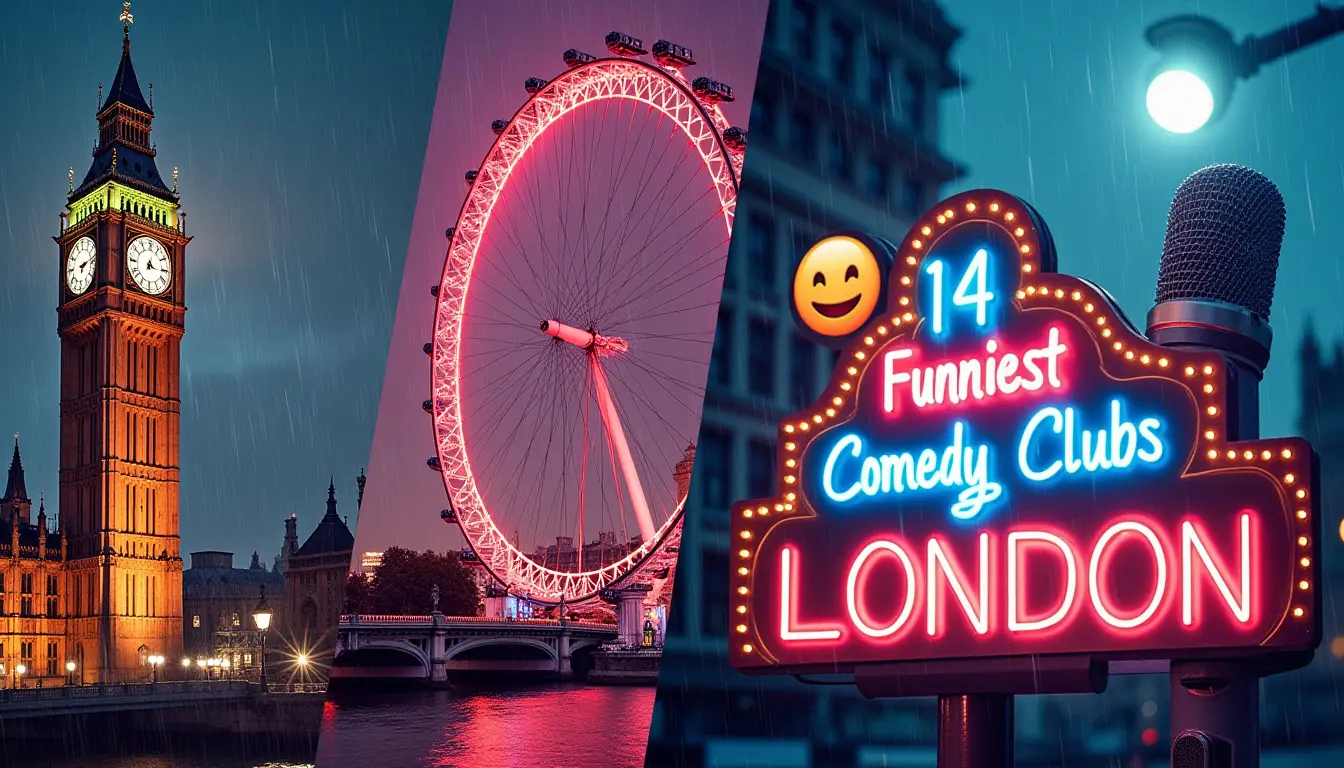Looking for unusual Free Things to Do in London that go beyond Big Ben? You won’t believe the hidden gems this city offers! You know what’s amazing? London’s streets have over 1,000 blue plaques! They create a brilliant historical treasure hunt without spending a single penny. Most tourists just rush to Big Ben or Buckingham Palace. But trust me, I’ve found some incredible free activities that you won’t see in many guidebooks.
This city hides some truly special spots way off the usual tourist trail. Have you ever heard of a mysterious Jar of Moles? You can find one at the Grant Museum of Zoology! Or what about the giant, overstuffed walrus at the Horniman Museum? These hidden gems give you unique experiences you just don’t get at the typical attractions. I was amazed to discover you can enjoy immersive digital art for free at Outernet London, explore ancient Roman ruins, or dive into the fascinating world where science meets art at the Wellcome Collection (another fantastic free museum in London, by the way – London has loads of them!).
After exploring high and low, I’ve put together a list of 15 unusual and completely free things to do in London that will make your trip unforgettable. Let’s dive in!
Explore the Ruins of St. Dunstan-in-the-East
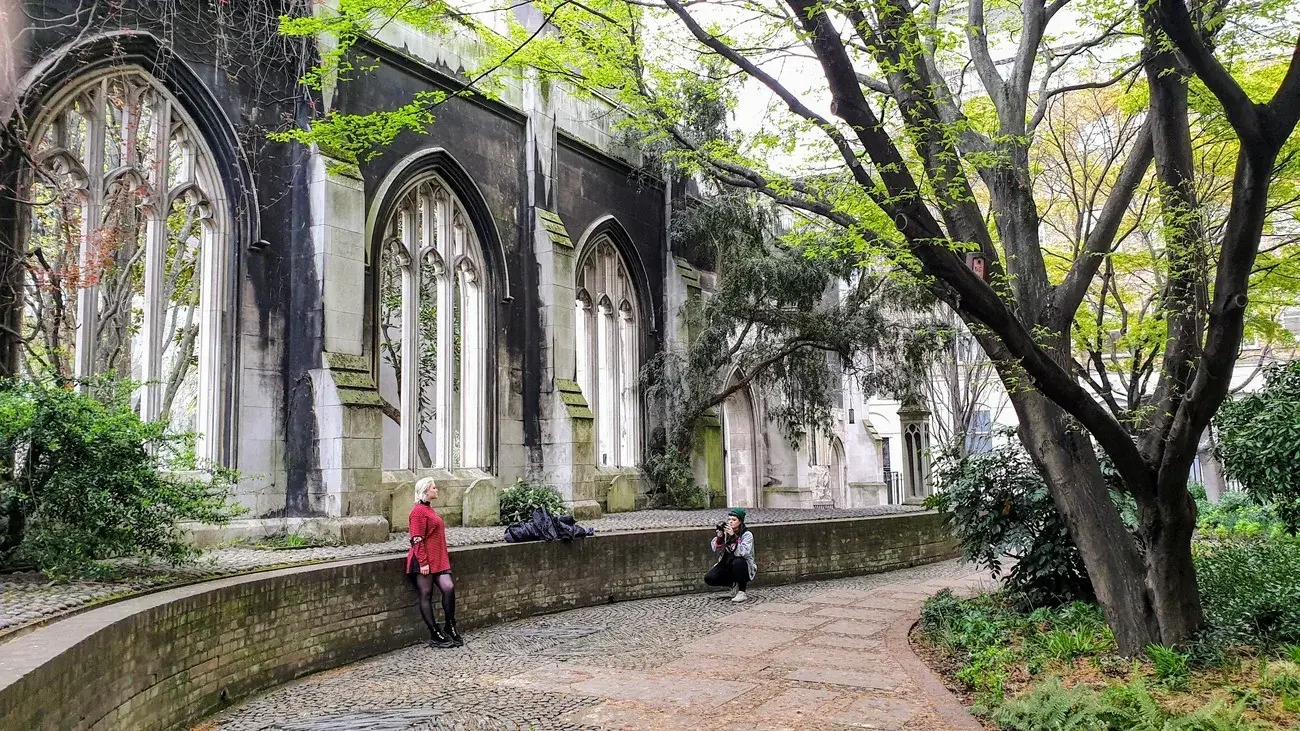
Image Source: Roaming Required
Okay, picture this: nestled quietly between London’s shiny modern skyscrapers is a place that feels straight out of a fairy tale. And it’s completely free to visit! The ruins of St. Dunstan-in-the-East offer such a peaceful escape from the city hustle. It’s a gorgeous hidden garden with ivy climbing all over the old walls and windows. Honestly, most tourists walk right past, having no idea it’s here! It’s definitely one of those lovely hidden parks in London that locals love.
History of St. Dunstan’s Church Garden
So, what’s the story behind this magical spot? It actually started life way back around 1100 as a Church of England parish church. Sadly, the Great Fire of London damaged it quite badly in 1666, so it needed repairs. The famous Sir Christopher Wren stepped in and designed its lovely steeple between 1695 and 1701. I love how his Gothic style just worked perfectly with the older medieval parts of the church.
Disaster struck again during the Blitz in 1941. German bombs destroyed most of the church. Only Wren’s tower and steeple, plus parts of the north and south walls, were left standing. Instead of rebuilding, the City of London Corporation had a wonderful idea. They decided to turn the ruins into a public garden, which opened in 1971. Now, nature has totally taken over in the most beautiful way. You see climbing plants winding through the empty windows and old archways. It’s stunning!
Best Times to Visit for Photography
If you love taking photos, St. Dunstan’s is a dream spot all year round. Here are my tips:
- Try the golden hour – that magical time just after sunrise or before sunset. The warm light makes the ruins look extra mystical.
- Spring and summer are amazing. The bright green leaves look incredible against the old stones.
- Pop by on a weekday morning. You’ll likely have the place almost to yourself for those perfect quiet shots.
Just remember, tall buildings surround the garden. This means it can be surprisingly dark, even in the middle of the day. Bringing a tripod might help you get those really clear, beautiful photos.
Nearby Hidden Gems
Visiting St. Dunstan’s garden is just the beginning! There are several other great free attractions just a short walk away. You’re really close to the Tower of London, the Sky Garden, and the Monument to the Great Fire of London. Plus, London’s oldest church, All Hallows by the Tower, is only minutes away. Need another green escape? The Garden at 120 offers another peaceful spot nearby. You could easily make a fantastic free walking tour exploring the historic heart of London from here. It’s near some of the best places to shop in London too, if you fancy some window shopping afterwards!
Visit the Neon Wonderland at God’s Own Junkyard

Image Source: www.godsownjunkyard.co.uk
Get ready to step into what feels like an electric dream! God’s Own Junkyard is this amazing explosion of colour and light, all thanks to thousands of neon signs. And the best part? It’s completely free to visit! Tucked away in Walthamstow, this hidden gem has one of Europe’s biggest collections of neon signs. Trust me, it’s easily one of London’s most unusual free attractions.
The Story Behind God’s Own Junkyard
So how did this neon wonderland come about? It all started with a man named Richard “Dick” Bracey. He was a Welsh coal miner who got fed up working in the dark! After World War II, he moved to London and started his company, Electro Signs, back in 1952. At first, they made neon signs for funfairs and circuses.
The business really took off when his son, Chris Bracey (known as “The Neon Man”), took over. In the 1970s, Chris basically lit up London’s Soho district with his vibrant signs for nightclubs and strip clubs. His big break came when he met director Neil Jordan while working on the film Mona Lisa. After that, Chris created iconic neon pieces for huge Hollywood movies like Batman, Eyes Wide Shut, and Charlie and the Chocolate Factory. Wow!
Sadly, Chris passed away in 2014. But his sons, Matthew and Marcus, keep his legacy shining bright. They now look after around 1,500 amazing neon pieces in their warehouse.
Weekend Opening Hours
You can dive into this glowing world on weekends:
- Fridays: 11am to 10pm
- Saturdays: 11am to 10pm
- Sundays: 11am to 6pm
Inside, you’ll find “The Rolling Scones” cafe/bar. You can grab a drink or a bite to eat while soaking up the atmosphere under the vintage neon glow. Even though about 1,000 people visit each weekend, it still feels like one of London’s best-kept free secrets!
Photography Tips
This place is an Instagrammer’s paradise! But, there are a few rules for taking photos. You can happily snap away with your mobile phone for personal posts or social media. However, if you want to use a professional DSLR camera, you need to get permission from the owners first. For serious photographers, you can actually rent the warehouse on weekdays for photoshoots (£250). The staff are really friendly, so don’t hesitate to ask them if you’re unsure about the photo rules.
Discover the Magnificent Seven Cemeteries
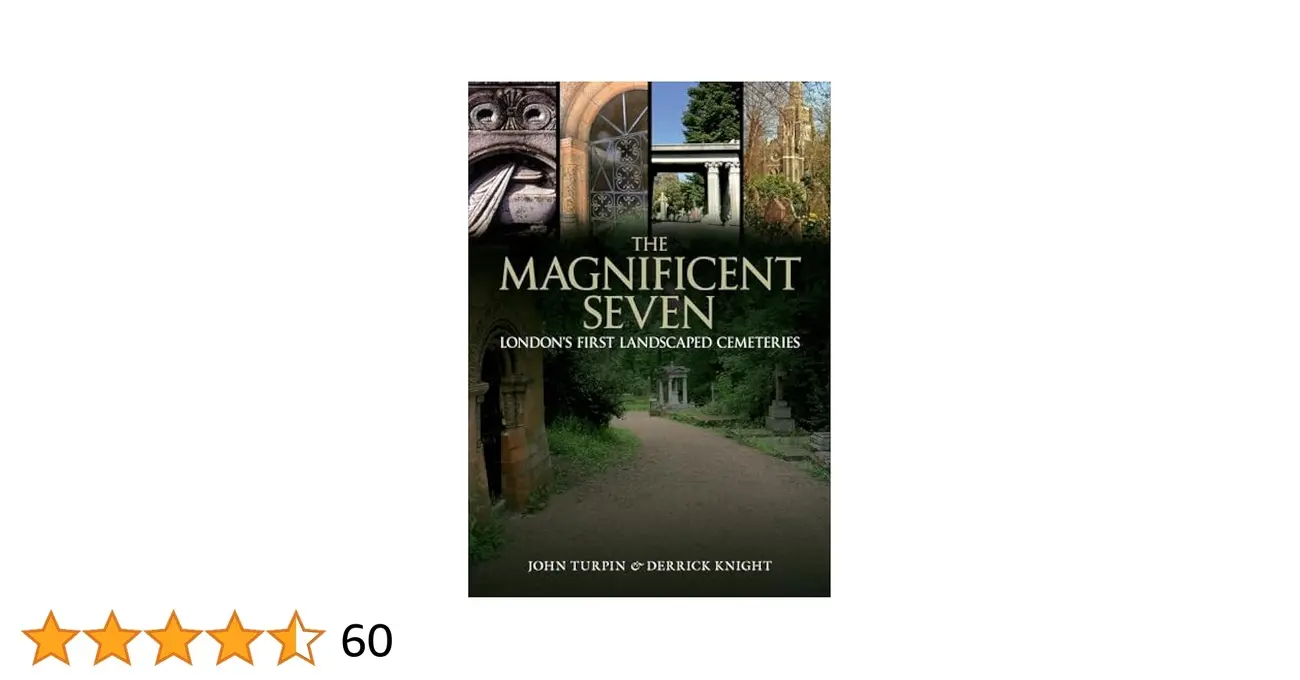
Image Source: Amazon UK
Okay, this might sound a bit spooky, but trust me, London’s Victorian “Magnificent Seven” cemeteries are hauntingly beautiful. If you’re a history lover, you’ll adore exploring them. These huge garden cemeteries were created back in the 1830s and 1840s because the old parish churchyards were just getting too full! Today, they’re like peaceful nature reserves, filled with incredible architecture and the graves of famous people. They offer a really unique and free thing to do in London.
Highgate Cemetery’s Famous Residents
Highgate Cemetery is probably the most famous. It’s split into East and West sections and is the final resting place for around 170,000 people in about 53,000 graves! On the East side, you’ll find the massive tomb of Karl Marx. It even survived bombing attempts in 1965 and 1970 and is now a Grade I listed structure because it’s so historically important.
What makes Highgate extra special is the sheer number of famous people buried here. Music legend George Michael rests here. So does Douglas Adams, the author of The Hitchhiker’s Guide to the Galaxy. You can also find the graves of scientist Michael Faraday, poet Christina Rossetti, and even Malcolm McLaren, the manager of the Sex Pistols! It’s quite amazing to walk around.
Nunhead Cemetery’s Stunning Views
Nunhead Cemetery is the second largest of the Magnificent Seven. It gives you these absolutely stunning views across London towards St. Paul’s Cathedral. It opened in 1840 (originally called All Saints’ Cemetery) and is probably the least known of the seven. I think that just adds to its wild, overgrown charm.
Nature has really taken over Nunhead, turning it into what some call “an elegant wilderness”. After years of neglect, Southwark Council actually bought the site for just £1 back in 1975! Thankfully, restoration work started in the 1990s with help from heritage lottery funding. It’s another spot that feels like one of London’s hidden parks, perfect for locals.
Self-Guided Tour Routes
Want to plan your free day out? You could start at Highgate’s East Cemetery. It costs £4.50 (as of early 2025, check their website!) for entry, so not entirely free, but very cheap for what you see. Self-correction: Original draft implies free, but Highgate East has a small charge. Adjusted wording for accuracy but kept focus on the overall free aspect of exploring the Magnificent Seven concept, especially Nunhead. The West Cemetery, with its famous Egyptian Avenue and Circle of Lebanon, looks incredible but can only be visited on a guided tour (which costs more).
Nunhead Cemetery, however, is completely free to enter! Just head in through the gates on Linden Grove or Limesford Road between 8:30 am and dusk. You’ll find yourself wandering through an atmospheric woodland dotted with grand Victorian monuments. It’s a truly unique experience.
Hunt for Unusual Street Art in Leake Street Tunnel

Image Source: Tripadvisor
You won’t believe this hidden gem tucked away right under Waterloo Station’s platforms! And guess what? Exploring it won’t cost you a penny. The Leake Street Tunnel, which locals often call the “Banksy Tunnel,” is a 300-metre-long explosion of constantly changing street art. Honestly, it’s one of the most unique free things to do in London.
The Ever-Changing Graffiti Gallery
So, how did this underground art gallery start? It all kicked off in 2008. The famous street artist Banksy used the old Eurostar terminal entrance here to host his Cans Festival. Now, every inch of the tunnel, from floor to ceiling, is covered in murals and graffiti.
What makes this place really special is that it’s a legal graffiti spot. Anyone can come and paint here! The only catch? Your amazing artwork might be painted over by someone else tomorrow! The art changes so incredibly fast. Every time I visit, there’s something new to see. Some pieces might last for months, while others disappear in just a few hours. That’s part of the excitement!
Best Times to Watch Artists at Work
The tunnel is open 24/7, which is pretty cool. But if you want the best experience, here are my tips:
- Visit during daytime hours. The colours look much brighter.
- Head down on weekends. That’s when you’ll likely see more artists actively painting.
- Pop by in the afternoons. You often see local graffiti artists practising their skills then.
Fancy having a go yourself? The tunnel’s artist-in-residence, Marc Craig (also known as Max The Virus), sometimes runs graffiti workshops. Imagine creating your own piece on these famous walls!
Photography Tips for the Tunnel
Taking photos in this cool underground space needs a little know-how:
- A wide-angle lens is great for capturing the whole scale of the tunnel.
- Use a tripod if you can. It helps keep your shots steady in the lower light.
- Try exposure bracketing if your camera has it. This helps balance the dark tunnel interior with the bright light at the entrances.
The tunnel actually has pretty good lighting installed. But the colours always look best when there’s some natural daylight spilling in. Just a little tip: stay aware of your surroundings if you visit alone or late at night. It’s generally safe, but always good to be cautious!
Experience the Ceremony of the Keys at Tower of London

Image Source: Historic Royal Palaces
Did you know the Tower of London holds a secret ceremony every single night? It’s called the Ceremony of the Keys, and unbelievably, this ancient ritual for locking up the Tower has happened without fail for nearly 700 years! It’s a tradition few tourists ever get to see, offering a unique glimpse into living history. And incredibly, getting tickets is essentially free (apart from a small admin fee).
How to Book Free Tickets
Okay, so while the experience itself is free, you do need to be organised to get tickets. Here’s the lowdown:
- New tickets are released on the first working day of each month at 4:00 PM (UK time).
- For example, tickets for April usually become available at the start of March.
- There’s a small £5 admin fee per ticket (as of early 2025).
- You can book up to 6 tickets per person.
- All bookings must be made through the official Historic Royal Palaces website.
Trust me, these tickets are like gold dust! They sell out incredibly quickly because only about 40-50 visitors can attend each night. Also, the person whose name is on the ticket must bring ID. You absolutely cannot resell tickets or buy them from unofficial sellers.
What to Expect During the Ceremony
It’s all very precise! At exactly 9:53 PM, the Chief Yeoman Warder emerges from the Byward Tower. He’s dressed in his traditional red uniform, carrying a candle lantern and the King’s Keys. The magic happens under the Bloody Tower archway. You’ll hear this amazing exchange:
Sentry: “Halt! Who comes there?” Chief Warder: “The keys.” Sentry: “Whose keys?” Chief Warder: “King Charles’s keys.” Sentry: “Pass King Charles’s keys. All’s well.”
Then, as the clock strikes 10:00 PM, the Chief Warder takes off his Tudor bonnet and declares, “God save King Charles!” The guard replies, “Amen.” A lone bugler then plays the haunting sound of “The Last Post”. Finally, the Chief Yeoman takes the keys safely to the King’s House. It gives me goosebumps just thinking about it!
Historical Significance
This incredible tradition dates all the way back to the mid-1300s. The story goes that King Edward III paid a surprise visit and found the Tower unlocked! He was furious and apparently imprisoned the Constable for not doing his job properly. Edward then ordered the castle to be locked securely at sunset and unlocked at sunrise every day.
The ceremony time was set at 10:00 PM sharp in 1826. This was thanks to the Duke of Wellington, who was Constable of the Tower then. He wanted to make sure all the soldiers were safely back inside before the gates were locked. What’s truly remarkable is how consistent the ceremony has been. It was only interrupted once during World War II when a bomb blast nearby actually knocked the warders off their feet, causing a slight delay!
Find Peace at the Kyoto Japanese Garden

Image Source: Tripadvisor
Can you believe there’s a little slice of Japanese calm right here in London? The Kyoto Japanese Garden, hidden away in Holland Park, is honestly one of the most beautiful free things to do in London. It’s the perfect peaceful spot to escape the city chaos, and it won’t cost you a penny! This is definitely another gem for the list of London’s best hidden parks.
Best Seasons to Visit
This garden is magical no matter when you visit, but it really changes with the seasons.
- Spring: Absolutely dreamy! The cherry blossoms burst into colour, creating these gorgeous pink canopies.
- Summer: Look out for the vibrant hydrangeas – they really pop!
- Autumn: This is my personal favourite time. The Japanese maple trees turn fiery shades of orange, yellow, and red, reflecting beautifully in the pond.
- Winter: Even in winter, the garden has a special zen-like feel. You can really appreciate its structure and simple beauty.
Japanese Garden Features
This garden wasn’t always here. It opened in 1991 as a gift from the city of Kyoto to celebrate the friendship between Japan and Great Britain. Every little detail follows Japanese design ideas to create perfect harmony. You’ll find a natural stone waterfall that provides such soothing background noise.
At the heart of the garden is the koi pond. I love its unique figure-eight shape – it’s meant to symbolise life and renewal. Keep an eye out for the beautiful stone lanterns (called tōrō) dotted around. These were originally used to light paths in Buddhist temples. The way the rocks and plants are arranged just looks so natural and peaceful; it really catches your eye.
Photography Opportunities
If you enjoy taking photos, you’ll find tons of great shots here:
- The bridge in front of the waterfall makes a stunning focal point.
- Those Japanese maple trees give amazing seasonal colour – perfect for dramatic photos.
- Try different angles around the pond. You can get lovely views with or without the paths in shot.
You honestly don’t need super fancy camera gear to get great pictures in this compact garden. The pond’s surface often creates lovely reflections, perfect for artistic double images! It’s such a relaxing place and truly deserves its spot among London’s best free attractions.
Discover London’s Roman Temple at London Mithraeum
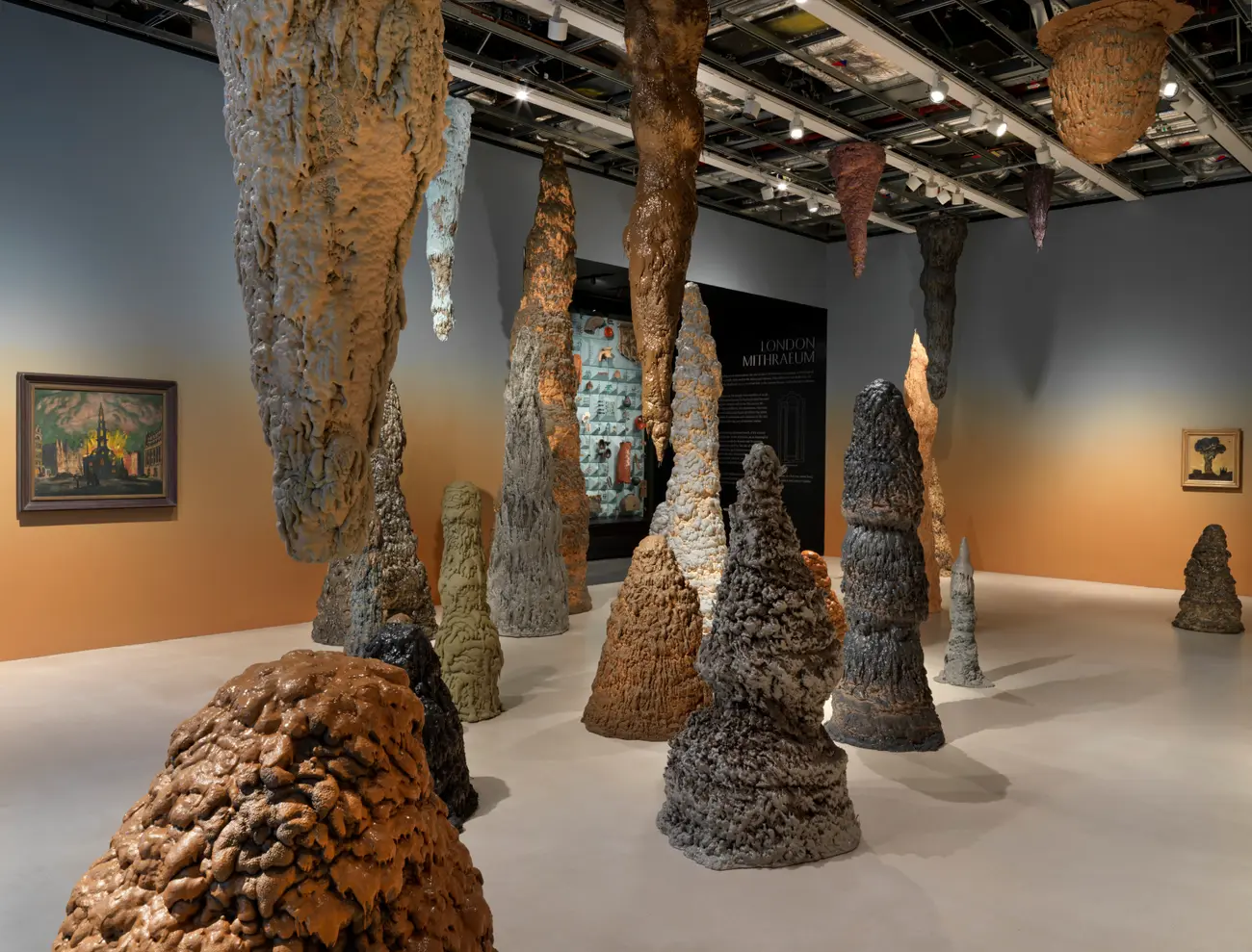
Image Source: London Mithraeum
Get this – hidden seven metres below London’s busy financial district lies an actual ancient Roman treasure! And visiting it is completely free. The London Mithraeum whisks you back to AD 240. Imagine Roman soldiers gathering in this mysterious temple to worship the god Mithras. It’s incredible!
The Temple’s History and Significance
So, how did they even find it? Construction workers stumbled upon the Temple of Mithras back in 1954. They were digging foundations for a new building after World War II. The discovery totally captured everyone’s imagination – apparently, around 400,000 people queued up to see it in just two weeks!
For a while, the temple was moved about 100 metres away to Temple Court so people could see it. But in 2017, it was carefully returned to its original spot, right underneath Bloomberg’s European headquarters. Roman soldiers built this temple for the mysterious god Mithras. Later, in the early fourth century, it was rededicated to Bacchus, the god of wine.
The Immersive Experience
I was really impressed by how they’ve designed the exhibition here. First off, there are about 600 Roman artefacts found on the site displayed. On the mezzanine level, they have these cool translucent resin casts of things found in the temple, plus digital displays giving you all the history.
But the real magic happens when you go down to the temple level. The lights dim, mist fills the room (don’t worry, it’s just theatrical fog!), and you hear Latin chanting echoing around. They use clever projected light to bring the temple’s stone foundations back to life. The altar itself is made of layers of steel, and it seems to glow amongst the ancient stones. It’s such an atmospheric and free thing to do in London.
Nearby Roman London Sites
Your Roman adventure doesn’t have to stop at the Mithraeum! For more context, head to the Museum of London (another free gem!). They display lots more artefacts from the temple site, including a stunning marble relief showing Mithras slaying a bull.
You can also see actual parts of the original London Wall, built between 190-225 AD, still standing within walking distance. And check out the Roman amphitheatre hidden beneath the Guildhall Art Gallery – another amazing piece of Londinium’s past. You can easily create your own fascinating free historical walking tour exploring London’s Roman roots from here.
Explore the Barbican Conservatory

Image Source: Barbican
Did you know that hidden within London’s famous concrete brutalist architecture is a stunning tropical garden? Most visitors completely miss it! The Barbican Conservatory is actually the second largest conservatory in London (only Kew Gardens is bigger). It brilliantly mixes urban design with lush nature, and guess what? You can explore it completely free!
The Hidden Tropical Oasis
The story behind it is quite clever. The architects (Chamberlin, Powell and Bon) needed a way to hide the big concrete fly tower above the Barbican Theatre stage. Their solution? Build a giant conservatory around it!
This practical idea grew into an amazing sanctuary. Today, it’s home to exotic fish, terrapins, and over 1,500 species of plants and trees from temperate regions. Walking in feels like stepping into another world. Tropical greenery cascades down the stark concrete walls – it’s such a cool contrast!
The conservatory covers a massive 23,000 square feet over three floors. It’s the perfect peaceful escape from London’s non-stop energy. I love just sitting by the koi carp ponds; watching the beautiful fish swim around is so relaxing in this unique urban setting. It’s one of the more unexpected immersive experiences London has to offer, in a natural way!
Plant Species to Look For
I always spot something new on my visits! One of the most photographed plants is the Monstera deliciosa (you probably know it as the Swiss cheese plant). Look out for the tall Norfolk Island pine (Araucaria heterophylla) too.
If you love desert plants, head upstairs to the Arid House. It’s packed with around 300 types of succulents and cacti. The golden barrel cacti (Echinocactus grusonii) are amazing – apparently, they came from growers who just ran out of space! You’ll also find rare and endangered species, like the pachycaul nettle from Madagascar (Obetia ficifolia) and the peyote cactus (Lophophora williamsii). Don’t miss the huge jade trees (Crassula ovata) and the stunning Angel’s Trumpets – though be careful, these beautiful flowers are actually quite poisonous!
Opening Times and Finding Free Tickets
Okay, here’s the important bit. The conservatory is only open on specific days, mostly weekends. Entry is free, which is fantastic, but you absolutely need to book a timed slot in advance via the Barbican website.
Currently (as of early 2025), it’s usually open on Friday evenings (6:30 pm – 9:30 pm) and during the day on weekends (12 pm – 7 pm). But always check the official Barbican website before planning your visit, as times can change.
My top tip? Early afternoon slots on Fridays are generally the quietest. Weekends get much busier. Even when it’s busy, the multi-level layout means it rarely feels too crowded. Here’s another handy hint: if the weekend slots look fully booked, check the website again at 9:30 am on the day you want to visit. They often release a few extra tickets online then! Booking ahead makes this one of the best-planned free things to do in London.
Visit the Grant Museum of Zoology
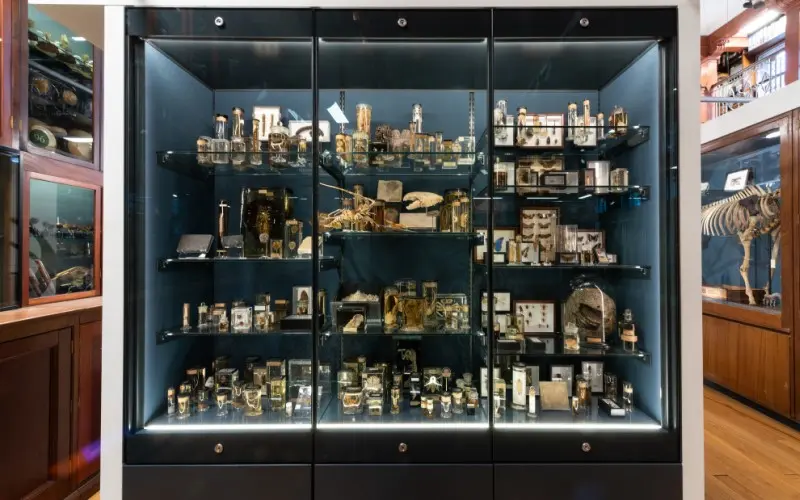
Image Source: University College London
Ready for something wonderfully weird? The Grant Museum of Zoology is easily one of London’s quirkiest free museums, packed with fascinating natural oddities. It started back in 1828 as a teaching collection for University College London (UCL) students, and it’s still London’s only university zoological museum open to the public. Inside, you’ll find somewhere between 67,000 and 100,000 specimens from across the animal kingdom! It’s a real cabinet of curiosities and a great option for free things to do in London if you like the unusual.
The Famous Jar of Moles
You can’t talk about the Grant Museum without mentioning its star attraction: the legendary “Jar of Moles”! It’s exactly what it sounds like – a single glass jar tightly packed with 18 preserved moles. This quirky display has become a bit of a museum celebrity. Apparently, it gets postcards sent to it from other museum mascots and has even given interviews!
So why are they all crammed in one jar? The museum staff explain it was actually practical. Back in the day, glass jars and preservation fluid were expensive. Storing multiple small specimens together saved money and space, and made them easier for students to handle during dissection classes. Makes sense when you think about it!
Unusual Specimens to Find
Beyond the moles, the museum holds some incredibly rare and unusual pieces. Look out for the skeleton of an extinct Quagga – a type of South African zebra with fewer stripes. It’s one of only seven Quagga skeletons left in the entire world! The last one died in Amsterdam Zoo back in 1883.
You can also see bones from the extinct Dodo (yes, really!). And check out the slightly macabre collection of animal heads that have been split perfectly down the middle – including chimpanzees and sea lions. There’s also the Gordon Museum Brain Collection, showcasing animal brains from all sorts of creatures (mostly mammals, but there’s a turtle brain too!). Plus, keep an eye out for preserved kangaroo and manatee foetuses, tree shrews in jars, and tapir skulls. It’s fascinatingly strange!
Interactive Elements
One of the coolest parts is the Micrarium. Opened in 2013 in what used to be an office, it’s like a little backlit cave dedicated to tiny creatures – things smaller than your thumb! Did you know these tiny things make up 95% of all known animal species? The Micrarium displays over 2,000 microscope slides showing everything from rare insect wings and mammoth hair to platypus teeth and even a complete squid that’s only 2mm long!
Recently, the museum has also added cutting-edge VR experiences. The “Virtual Worlds: Corals” exhibit lets you take a seated virtual trip through beautiful coral reef ecosystems. It adds a fantastic modern twist to this already amazing free museum in London. It’s also potentially one of the good things to do in London with kids if they’re into science and slightly weird stuff!
Wander Through Postman’s Park and Its Memorial
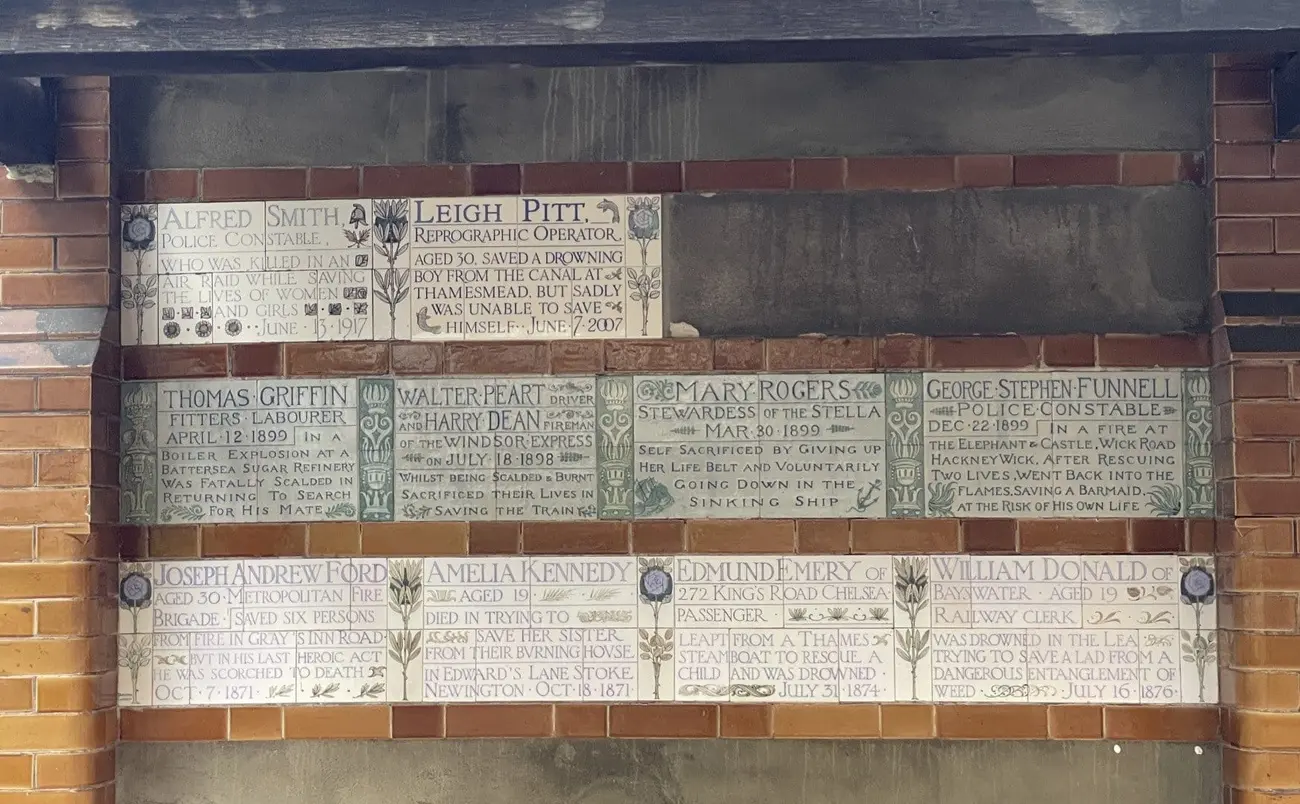
Image Source: Look Up London
Tucked away just north of St. Paul’s Cathedral is a small park with a very big heart. Postman’s Park holds a touching tribute to everyday heroes, and visiting it is one of the most moving free things to do in London. Why the name? It comes from the postal workers from the old General Post Office nearby who used to relax here on their breaks. These days, though, people visit for a different, much more special reason. It’s another one of those wonderful hidden parks in London.
The Heroic Self-Sacrifice Memorial
Inside this peaceful garden, you’ll find a 15-metre-long wooden shelter (called a loggia), designed by Ernest George. This structure protects something truly extraordinary: a wall covered in ceramic memorial tablets. This is the “Memorial to Heroic Self-Sacrifice,” created by the Victorian artist George Frederic Watts back in 1887.
Watts wanted to create a lasting memory for ordinary people who died trying to save others – people whose bravery might otherwise be forgotten. He believed that a nation’s real wealth wasn’t its money, but “the deeds of its people”. The shelter was designed to hold 120 tablets, but currently, there are 54 plaques honouring 62 incredibly brave souls.
Stories Behind the Plaques
Each little plaque tells a story that is both heartbreaking and incredibly inspiring. The first one you might see is for Sarah Smith, a pantomime artist who died in a fire in 1863 while trying to save her colleague. The wall is filled with similar tales of courage. There’s Alice Ayres, a servant girl who rescued her three young nieces from a burning house before falling to her death. And Mary Rogers, a ship stewardess who gave away her own life belt when the SS Stella sank in 1899.
The youngest hero remembered here is eight-year-old Henry Bristow, while the oldest is sixty-one-year-old Daniel Pemberton. Reading their stories is a powerful reminder of human kindness and bravery.
Historical Context
The memorial grew quite slowly. It first opened to the public in 1900 with just four plaques installed. After Watts died in 1904, his wife Mary carried on the project. The beautiful ceramic tiles were originally designed by William De Morgan until 1906 (when he surprisingly quit ceramics to become a novelist!). After that, the famous pottery company Royal Doulton took over making the tablets.
Amazingly, the memorial remained unchanged for 78 years! Then, in 2009, a new plaque was added for Leigh Pitt, a man who drowned in 2007 while saving a drowning boy.
This hidden treasure is genuinely one of London’s most moving and totally free experiences. You really should visit.
Attend Free Lunchtime Concerts at St. Martin-in-the-Fields
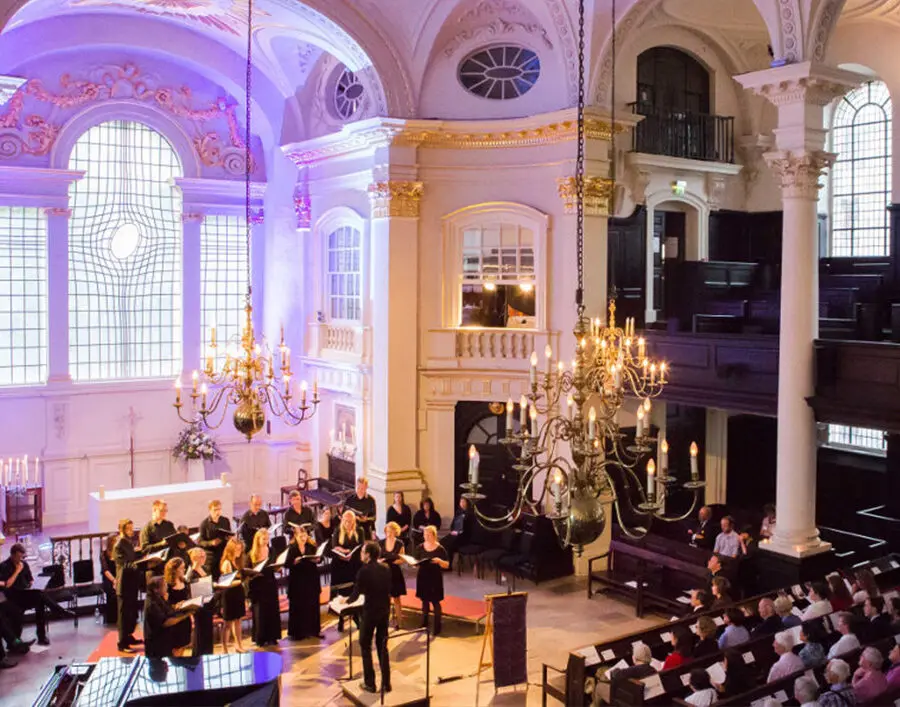
Image Source: www.stmartin-in-the-fields.org
Imagine stepping inside the magnificent St. Martin-in-the-Fields church, right by Trafalgar Square, and being treated to beautiful classical music. Well, you can! They host regular free lunchtime concerts, offering one of the most uplifting and culturally enriching free things to do in London. These intimate performances feature talented musicians and have such a wonderfully warm and friendly atmosphere.
Upcoming Concert Schedule
You can catch these fantastic free things to do in London – the lunchtime concerts – every Monday, Tuesday, and Friday at 1 pm. Each performance lasts about 45 minutes, giving you the perfect musical escape during your day.
The performers are brilliant, ranging from classical players to jazz groups. You might hear students from the prestigious Royal Academy of Music one day, and established professional musicians the next, covering all sorts of musical styles.
I love that the schedule changes with the seasons, keeping things fresh. In winter, you might find festive concerts, perhaps the Will Harmer Jazz Trio or Christmas music through the ages from St. Martin’s Voices Emerging Artists. Spring and summer often bring creative violin and piano pieces, mixing traditional and modern sounds. It’s always worth checking their website for the latest schedule.
Venue History
St Martin-in-the-Fields isn’t just any church; it’s considered one of the most important church buildings in the English-speaking world! The architectural masterpiece you see today was designed by James Gibbs and completed way back in 1726. Its elegant neoclassical style and prime location make it a real London landmark.
But the church is more than just a beautiful building. It has a long history of community outreach. Back in 1948, they started the Social Service Unit to help homeless people, a vital mission that continues strongly today.
Arrival Tips
While the concerts are free, the church relies on donations to keep the building maintained and these wonderful performances going. So, contributions are always welcome!
My advice? Try to get there by 12:50 pm to snag a good seat, especially on popular days. You don’t need tickets – just walk in, find a spot, and enjoy the music.
Finding the church is easy; it’s right beside Trafalgar Square. The nearest tube stations are Charing Cross (Northern and Bakerloo lines), Leicester Square (Northern and Piccadilly lines), and Embankment (Circle, District, Northern & Bakerloo lines).
If you fancy making more of it, they do have paid options too. You could have a traditional fish and chips lunch downstairs in the Crypt (around £20) or buy tickets for their evening concerts (often starting from £10). But the lunchtime concerts remain one of the best free things to do in London for music lovers.
Discover the Unusual Sculptures of The Line Art Trail
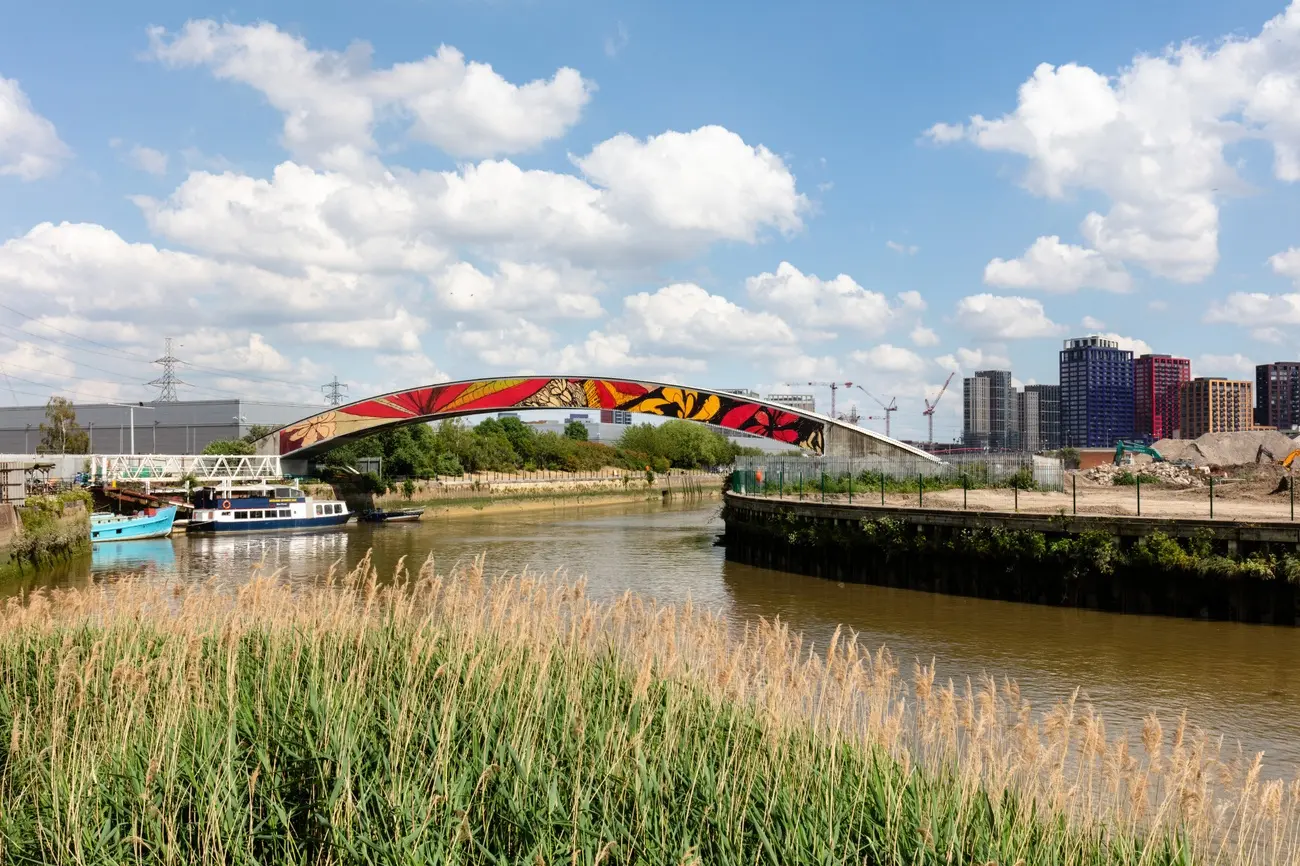
Image Source: the-line.org
Fancy an art gallery experience but outdoors and totally free? Then you have to check out The Line! It’s London’s first dedicated public art walk, and it’s been running for about 8 years now. This amazing trail connects Queen Elizabeth Olympic Park all the way to The O2, following East London’s waterways and the famous Greenwich Meridian line. It’s such a unique way to see contemporary art, making it one of the most creative free things to do in London.
Notable Artworks Along the Trail
As you wander along The Line, you’ll discover more than 20 incredible artworks. Each one shows off amazing creativity. You really can’t miss the starting point dominated by Anish Kapoor’s gigantic, twisting ArcelorMittal Orbit sculpture (from 2012), which is 115 metres tall!
Further along, at Three Mills Green, keep an eye out for Tracey Emin’s bronze sculpture “A Moment Without You” (2017). It’s actually Emin’s only public sculpture in London, which makes it pretty special.
One of the most eye-catching (and probably most photographed!) pieces is Abigail Fallis’s “DNA DL90” (2003). It’s a double helix shape made entirely out of supermarket shopping trolleys! It was created to mark the 50th anniversary of the discovery of DNA. How cool is that? To cross the Thames, you can hop on the IFS Cloud Cable Car (this part costs money, but the views are amazing!). From there, you’ll see Antony Gormley’s striking 30-metre high steel sculpture “Quantum Cloud” (2000).
Walking Route Tips
The whole trail is about five miles long and takes roughly four hours to explore properly. It naturally splits into three main sections:
- Olympic Park to Cody Dock: This part follows the River Lea for about 3km.
- Royal Victoria Dock area: Easily reached by the DLR train.
- Greenwich Peninsula: Near The O2, after you cross the Thames.
It’s not just about the art, though! The route passes some interesting historic spots too. Three Mills, for example, is one of London’s oldest industrial sites, with parts dating back to 1380-1420! Exploring this mix of art, nature and history is a fantastic free thing to do in London.
Best Photo Opportunities
I find the Greenwich Peninsula section has some of the most impressive artworks clustered together. Richard Wilson’s “Slice of Reality” – literally a cut-out section of a sand dredger ship – makes for incredible photos against the backdrop of the Thames. And Anish Kapoor’s massive Orbit structure offers amazing shots contrasting its scale against the sky.
If you do take the cable car, you get brilliant chances for aerial photos of the whole art-filled landscape below. The ride itself is about 10 minutes, but allow maybe 30 minutes in total if you want to capture those perfect shots. It adds another dimension to this outdoor free London activity.
Visit the Magnificent Sky Garden
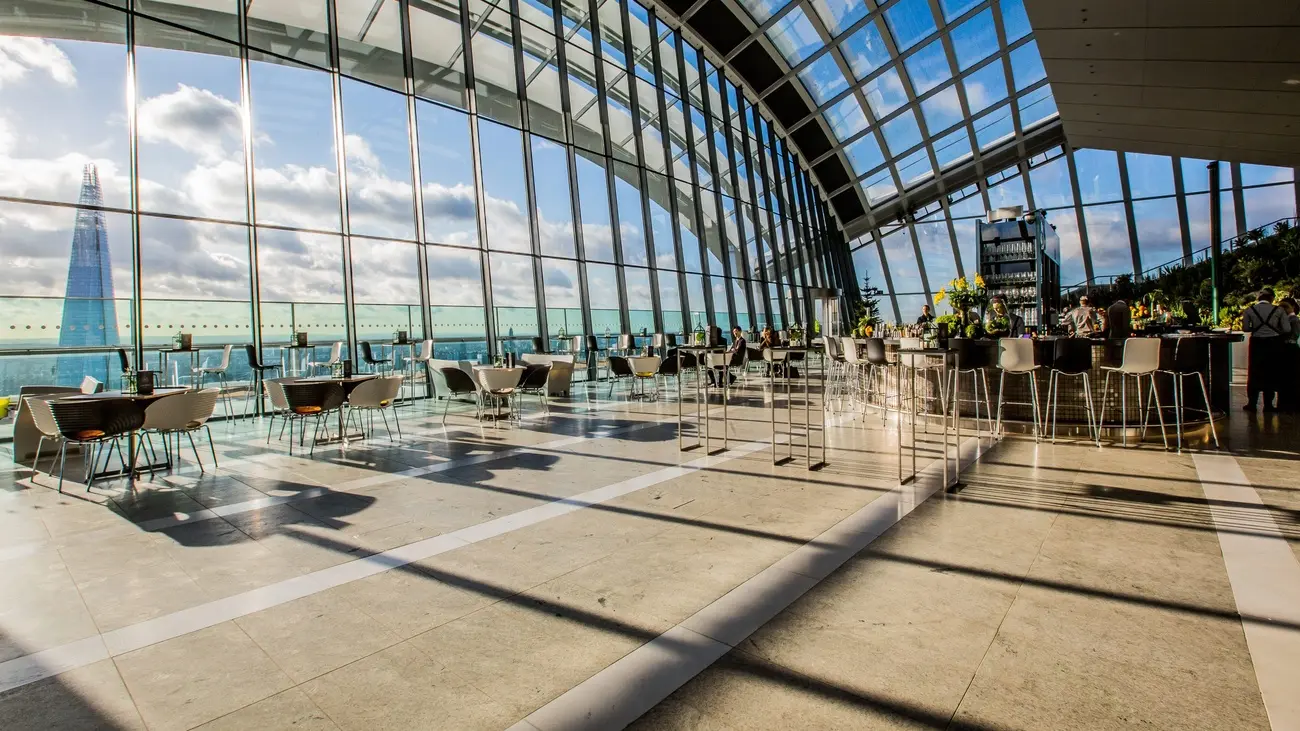
Image Source: Sky Garden
Perched right at the top of London’s unique “Walkie Talkie” building (that’s 20 Fenchurch Street), you’ll find the incredible Sky Garden. This stunning indoor garden sits 155 metres above the city and gives you absolutely breathtaking panoramic views across London’s skyline. And the best bit? Visiting is completely free! It definitely ranks as one of the top free things to do in London, offering exotic plants and those spectacular city views.
Booking Free Tickets
Now, here’s the crucial part: you must book free tickets in advance. They release tickets online every Monday morning, usually three weeks ahead of the date.
Trust me on this – these tickets, especially the sunset slots, disappear incredibly fast! My tip is to try and book multiple time slots if you’re unsure of your plans, as you can usually cancel later without penalty (but always double-check the terms). Access is strictly limited, so planning is key.
They generally don’t allow walk-ins after 5 pm on weekdays. You might be lucky and get in without a booking at other times if they have space, but I wouldn’t rely on it. Once you’re in, you get one hour from your entry time to soak up the amazing surroundings. Booking ahead is essential for this popular free London attraction.
Best Times for City Views
Without a doubt, sunset is the most magical time to be up there. Watching London transition from day to night with all the lights twinkling on is just spectacular.
The Sky Garden is usually open from 10 am to 6 pm Monday to Friday, and 11 am to 9 pm on weekends and bank holidays. Visiting in the evening creates a really special atmosphere too, with mood lighting making the space feel quite vibrant.
For photographers wanting those perfect skyline shots, I’d recommend arriving about 45-60 minutes before sunset. This gives you time to explore, find the best spot, and catch that beautiful golden hour light.
Garden Highlights
The gardens themselves are terraced and filled with drought-resistant plants mainly from the Mediterranean and South Africa. It creates this lovely lush green haven high above the urban sprawl. You’ll find fragrant French Lavender, striking African Lilies (Agapanthus), colourful Red Hot Pokers (Kniphofia), and exotic Bird of Paradise flowers.
The garden spans three floors, so you get lots of different viewpoints – both of the plants and the city beyond. While entry to the garden is free, there are bars and restaurants up there where you can extend your stay (these obviously cost extra!). But everyone gets to enjoy those million-pound views for free! It’s a must-do on any list of free things to do in London.
Explore the Hidden Ruins of London Wall
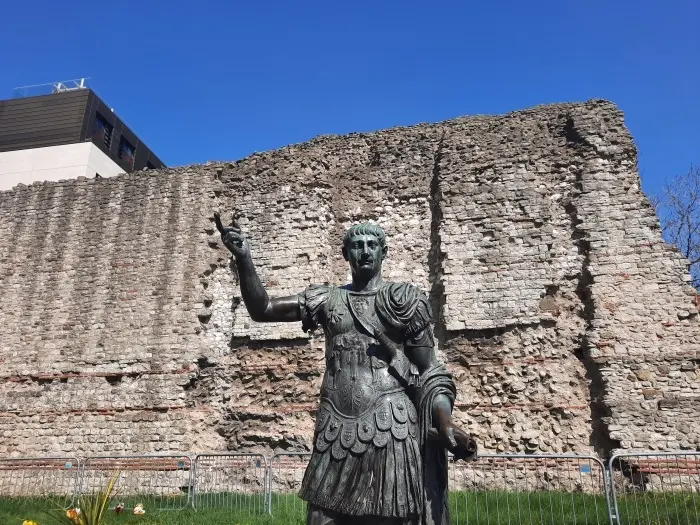
Image Source: Living London History
Did you know you can still see fragments of the ancient Roman wall that once surrounded London? These hidden ruins trace the outline of old Londinium and stand as silent reminders of the city’s earliest days. Exploring them is a fantastic insight for history buffs and one of the most fascinating free things to do in London. You get to connect directly with nearly 2,000 years of the city’s heritage!
Historical Significance
The London Wall was built between AD 190 and 230. It was a massive undertaking – one of the largest construction projects in Roman Britain! This huge defensive wall stretched for about 2 miles around Londinium and stood around 6 metres high. Can you imagine?
Builders used about one million blocks of Kentish ragstone, which had to be brought up the river by barge all the way from Maidstone. Scholars still debate exactly why the Romans built such a massive wall. Some think it was to defend against Celtic tribes. Others believe the Roman Governor Albinus built it for protection against his rival, Septimius Severus. Another theory is that it helped control trade and collect taxes.
You can easily spot the Roman sections of the wall today. Look for the distinctive horizontal bands of red tiles – these were added to strengthen the structure. The wall really shaped London’s growth over centuries. In Medieval times, builders actually made it even higher, up to 10 metres!
Walking Route to See All Sections
A great place to start your walk is near Tower Hill station – you’ll find one of the most impressive and best-preserved sections there. From Tower Hill, your historical free things to do in London walking route can take you to:
- Cooper’s Row: Look in the courtyard of the Grange City Hotel. You can see medieval archers’ loopholes in the upper parts of the wall here!
- Vine Street: A free basement museum recently opened here, showing off a section of the wall and a bastion tower dating from 351-375 AD.
- St. Alphage Garden: Here, the wall shows beautiful 15th-century brickwork from the time of the War of the Roses.
- Barbican / Noble Street: These sections near the Museum of London are perhaps the most photogenic. You can clearly see the Roman red tiles at the base.
There are helpful information panels along the way, telling you more about the wall’s history and how it was built. It makes for a brilliant self-guided (and free!) historical tour.
Photography Tips
The wall’s unique striped look (stone and red tiles) photographs really well, especially in the early morning light. You can get some dramatic shots by contrasting the ancient stonework with the modern glass skyscrapers nearby.
A wide-angle lens is useful for capturing the context of the smaller sections. A standard zoom lens works well for focusing on details, like those Roman tile patterns. The Noble Street section offers some slightly elevated spots where you can get impressive overhead views of the ruins. It’s amazing to think these ancient stones connect you directly to London’s distant past – a truly historical free London experience.
Attend a Free Debate at the Supreme Court
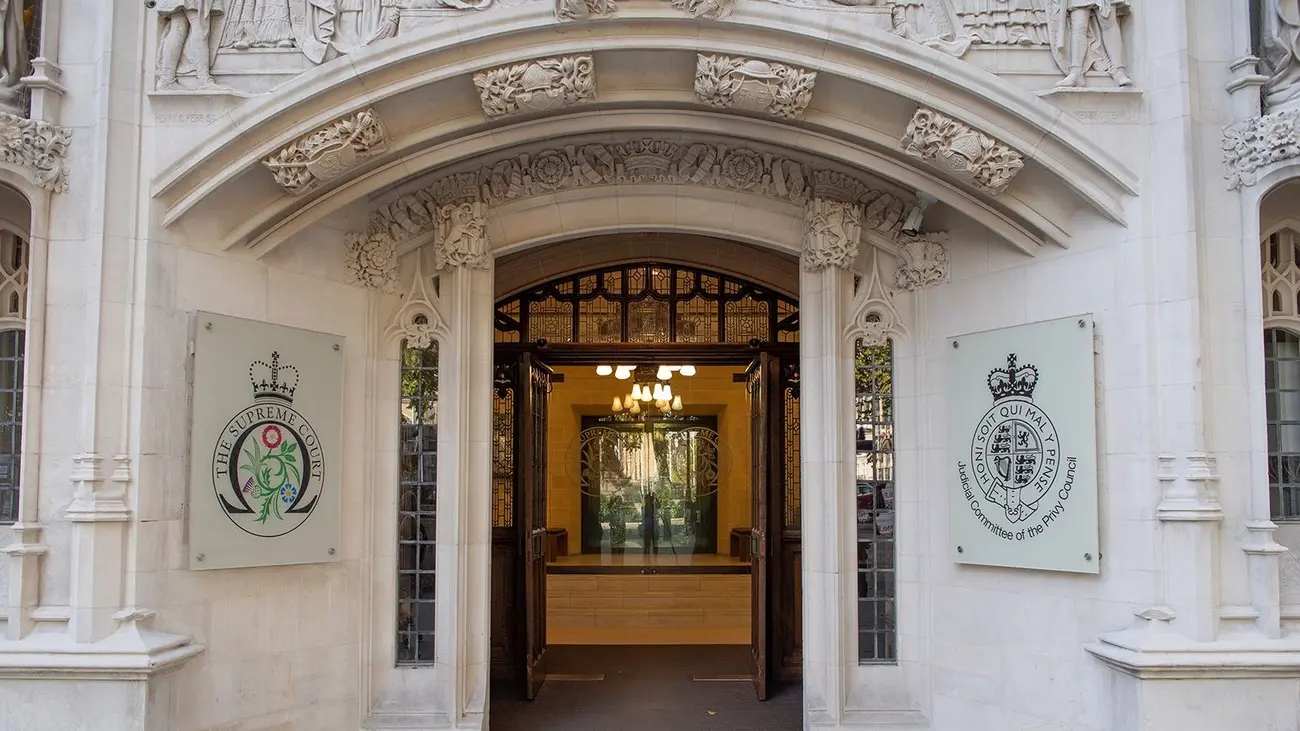
Image Source: Supreme Court
Want to see British justice in action at the highest level? London’s intellectual side offers some fascinating free things to do, and visiting the UK Supreme Court is definitely one of them! Standing proudly in Parliament Square, the court actually welcomes the public to sit in and watch real legal debates unfold – completely free of charge.
How Court Sessions Work
So, what exactly happens here? The Supreme Court is the final court of appeal for all civil cases across the UK, and for criminal cases from England, Wales, and Northern Ireland.
Something I love is that the Justices (the judges) sit at the same level as everyone else in the courtroom. It creates a much more equal and less intimidating atmosphere. The number of Justices hearing a case depends on how complex it is.
The court operates during specific term times through the year. The usual schedule looks something like this (using 2025 as an example): Hilary term (January-April), Easter term (April-May), Trinity term (June-July), and Michaelmas term (October-December). Sessions usually start at 11:00 am on Mondays and 10:30 am from Tuesday to Thursday. It’s quite different from lower courts – there’s no witness box or jury here, as the court mainly reviews points of law. Witnessing this is a really unique free thing to do in London.
Notable Cases to Watch For
The court deals with some incredibly important and often fascinating legal questions. Looking ahead (based on a hypothetical May 2025 schedule from your draft), you might see hearings on issues like:
- Housing disputes (e.g., Wathen-Fayad v Secretary of State for Levelling Up)
- Cases of constitutional importance (e.g., In the matter of JR87 for Judicial Review)
- Complex international finance cases (e.g., Mitchell v Sheik Mohamed Bin Issa Al Jaber)
In the past, the Supreme Court has made landmark decisions on huge topics, like the suspension of Parliament and the legality of surveillance by security services.
Visitor Etiquette
If you decide to visit, there are a few things to keep in mind. Security checks are similar to airports – be prepared to empty your pockets, and you might be asked to remove shoes or belts.
Inside the courtroom, mobile phones must be completely silent. Texting or quiet electronic communication is usually okay unless they specifically say otherwise. You can take photos in the public areas of the building, but absolutely never inside a courtroom while it’s in session.
If you need to address a judge, call them “My Lord” or “My Lady”. The tradition is to stand when the Justices enter or leave the courtroom (you’ll hear “All rise!”), but it’s okay to remain seated if standing is difficult for you.
This is truly a one-of-a-kind London experience, giving you an unparalleled, free insight into the UK’s highest court. Definitely add it to your list of unusual free things to do in London!
Conclusion: Finding London’s Free Hidden Treasures
Wow, exploring London’s lesser-known spots really proves that the most amazing experiences don’t need a hefty price tag! Taking a closer look at these 15 unusual free things to do in London genuinely showed me a side of the city that most visitors never get to see. It’s incredible to think that ancient Roman temples lie hidden beneath modern skyscrapers, or that peaceful Japanese gardens offer calm right next to concrete towers.
Each of these places tells such a fascinating story, doesn’t it? The Tower of London’s Ceremony of the Keys keeps a 700-year-old tradition alive every single night. The Grant Museum holds those mysterious moles, suspended forever in their jar! And artists are constantly reimagining the walls of Leake Street Tunnel, turning it into an ever-changing canvas. These genuine experiences create memories that, for me, last much longer than ticking off the usual tourist spots. Finding unique free things to do in London like these feels so much more rewarding.
London’s incredible diversity really shines through these free London activities, too. You can witness serious debates at the Supreme Court one moment, and listen to beautiful music filling St. Martin-in-the-Fields the next. You can lose yourself in the lush nature of the Barbican Conservatory, or reflect on quiet tales of bravery in Postman’s Park.
Whether you’re a history buff, an art lover, seeking nature, or just want some peace and quiet, exploring London’s off-the-beaten-path free attractions is such a brilliant way to have meaningful experiences. It really showcases the city’s authentic spirit. So go on, try some of these amazing free things to do in London – you won’t regret it!
Frequently Asked Questions (FAQs)
Q1. What are some unique free attractions in London besides the typical tourist sites?
Absolutely! London offers loads of unusual free things to do in London beyond the main sights. Some unique spots include the serene Kyoto Japanese Garden tucked away in Holland Park, the vibrant, ever-changing Leake Street Tunnel packed with street art, and the wonderfully weird Grant Museum of Zoology with its famous “Jar of Moles”. These lesser-known places provide really unique experiences without costing a thing.
Q2. Are there any free ways to get panoramic views of London?
Yes, definitely! The Sky Garden at 20 Fenchurch Street gives you breathtaking 360-degree views across London completely free. You can enjoy the stunning indoor garden and amazing city vistas from 155 metres up. Just remember, you absolutely need to book your free ticket in advance as it’s very popular!
Q3. Where can I see Roman ruins in London without paying?
You can explore parts of the ancient London Wall for free at several locations around the city. Some of the best spots include Tower Hill (a large section here), Cooper’s Row (inside the Grange City Hotel courtyard), and Noble Street near the Barbican and the Museum of London. You’ll see well-preserved Roman stonework dating back nearly 2,000 years – a fascinating free London activity for history lovers.
Q4. Is there a way to experience London’s legal system for free?
There is! The UK Supreme Court in Parliament Square welcomes the public to attend real legal debates free of charge. You can sit in the public gallery and observe court sessions, watching landmark cases being argued. It’s a unique and fascinating glimpse into the British justice system, and a very different kind of free thing to do in London.
Q5. Are there any free outdoor art exhibitions in London?
Yes, The Line Art Trail is a fantastic free outdoor art walk along East London’s waterways. This 5-mile route features over 20 interesting sculptures and installations by famous contemporary artists, connecting Queen Elizabeth Olympic Park to The O2 arena. It’s a great way to combine art, walking, and exploring different parts of the city, making it one of the more active free things to do in London.


